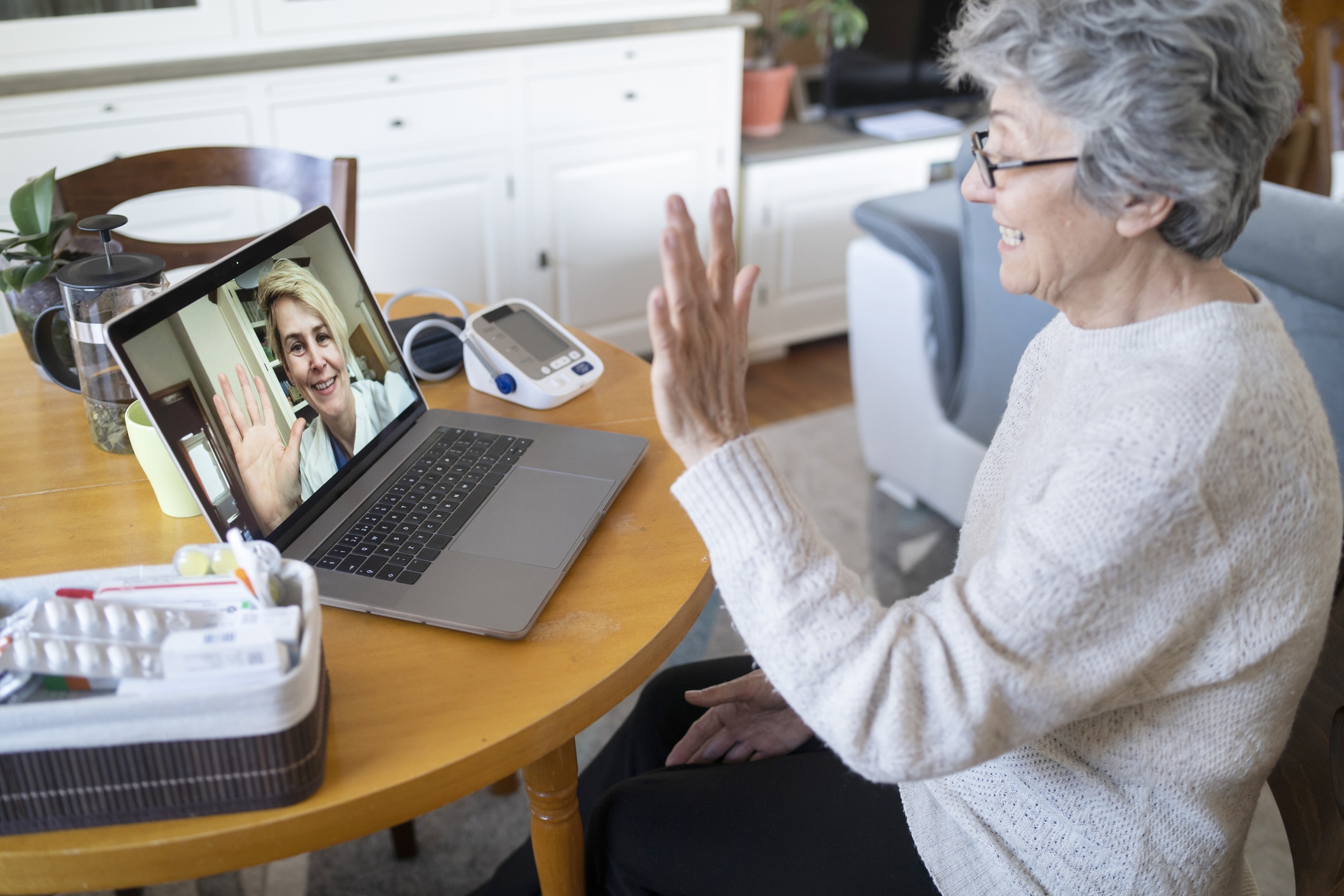
Patient engagement in healthcare is rising in importance as telemedicine and virtual care become a more common part of the healthcare landscape. The more things shift from in-person interactions to remote consultations, the more healthcare providers face both new opportunities and new challenges in keeping patients actively involved in their care.
While remote care has been gaining in popularity over the past decade, the COVID-19 pandemic kicked things into high gear, dramatically accelerating the widespread adoption of telemedicine solutions. Just like the many other industries that were forced to transform physical interactions into digital ones almost overnight, healthcare providers needed to find ways to conform to new social distancing guidelines.
The rate at which these remote healthcare options took off during the pandemic is astounding. For example, from March 2020 to April 2020, telemedicine visits at the Ohio State University Wexner Medical Center went from fewer than 100 visits per day to over 2,200 visits per day.
And while these solutions sparked in popularity due to the pandemic, there’s little reason to believe things will ever go back fully to the way they were before. One recent, sweeping study found that over 90% of patients rated their telemedicine experience as good or very good, and most thought that future telemedicine visits would be valuable.
People love convenience, and online consultations and virtual health visitations offer a level of convenience that is likely to stick around just like the many restaurants who introduced carry-out and delivery options and will never look back.
But healthcare providers need to do more than simply offer telemedicine solutions in order to best serve their patients in this new-look marketplace. They must leverage these new technological tools to drive patient engagement and patient retention.
This is especially true at a time when so much focus is being placed on “flattening the curve” of the ongoing pandemic, an approach which necessitates an emphasis on the aggregate rather than the individual. Healthcare providers must not lose focus on the human connections that form the underpinnings of patient engagement and personal care.
With that in mind, this article will explain what patient engagement is, why it’s important, and how to increase patient engagement at your healthcare practice.
Table of Contents
- What is Patient Engagement?
- Why is Patient Engagement Important?
- Patient Engagement Examples
- How to Increase Patient Engagement
- Strategies to Improve Patient Engagement
- Patient Engagement Solutions
- Leveraging Online Curiosity

What is Patient Engagement?
Patient engagement is the degree to which an individual takes an active role in their own healthcare. This includes independently researching symptoms, diagnosed illnesses, and treatment options; following healthcare instructions and prescriptions; and conducting ongoing consultations with healthcare providers.
Patient engagement in healthcare is driven by a team effort involving the patients, their families, clinicians and healthcare providers, insurers, and other representatives. Each of these individuals plays an important role in the partnership of shared decision making that contributes to a patient’s proactive health activities and prevention, as well as their ongoing care.
Engaged patients come to their healthcare provider with questions and ideas, and actively follow their physicians’ recommended treatment plans. They want to understand their symptoms and their diagnoses, chart their road to recovery, and build habits to maintain their health going forward.
Why is Patient Engagement Important?
Patient engagement is important because engaged patients are shown to have better health outcomes than non-engaged patients. This part should come as no surprise, as the measurement of patient engagement includes an individual’s willingness to follow prescribed healthcare routines.
But you may find it surprising that more engaged patients are often shown to benefit their healthcare providers as well. The World Health Organization notes that patient engagement is an integral component of healthcare delivery, and that feedback obtained through patient engagement plays a critical role in improving processes going forward.
So not only does an engaged patient have a better chance of successful treatment, but the information they provide back to their physicians helps improve the care other patients receive. It is this collaborative relationship that makes patient engagement such an important part of the modern healthcare ecosystem.
In fact, encouraging patient engagement and reacting to the lessons learned from engaged patients can create a sort of self-perpetuating feedback loop of improvement. The more you learn from your engaged patients, the more you can improve your practice. The more you improve your practice, the easier it becomes to drive patient engagement.

Patient Engagement Examples
There are many examples of what patient engagement looks like in the real world. Here are just a few:
- A patient is prescribed a new medication to treat an ongoing condition. After a few days of taking the medicine, they begin to develop a rash. Rather than simply discontinuing treatment, they instead contact their healthcare provider to find a new medication to treat their condition without adverse reactions and while still being covered by insurance.
- A patient is diagnosed with a gastrointestinal disorder and prescribed medication. The patient takes their medication, but also starts a journal of the foods they eat and the way they feel after eating. At a follow-up appointment, they present their physician with a list of “trigger foods.” The physician and the patient collaborate to create a modified diet plan, and the physician is able to dial back the prescribed medication as a result.
- A patient with a family history of skin cancer notices an irregularly shaped mole. Instead of waiting another six months for their regular checkup, they schedule an appointment with their physician to have the mole examined and possibly biopsied. Early detection is crucial to recovery rates, and this patient’s engaged behavior could have saved their life.
- A patient with a chronic illness is put on a new treatment plan by their physician. After a few weeks, the patient’s symptoms have subsided dramatically and they feel better than they have in a long time. The patient drops their physician a note through their patient portal to let them know things are going well and that the treatment is working.
- A patient’s insurance provider no longer covers a certain medication prescribed to the patient. Working in collaboration with their healthcare provider, the patient is able to find a suitable alternative medication that both treats their needs and fits their budget. This is a prime example of the collaborative decision-making process between patient, provider, and insurer.
- An otherwise healthy individual maintains regular checkups with their physician and undergoes all recommended preventative tests and health screenings. Furthermore, they exercise regularly, eat a healthy and well-balanced diet, and take an active interest in leading a healthy lifestyle. Any physician should hope to have their patients take their health so seriously on a daily basis.
Patient engagement will certainly take many forms, but they all share one thing in common: the patient takes on the onus of their own well-being and actively takes steps to improve or maintain their health. As you look to boost the levels of patient engagement, look for ways to get your patients involved in their own care.

How to Increase Patient Engagement
There are several important strategies healthcare providers can follow to increase patient engagement. No two practices are the same, so it’s important to experiment and see what resonates with your audience. However, there are plenty of tried-and-true approaches to increasing patient engagement. As you experiment with these strategies, keep communicating with your patients to find out what’s working.
Strategies to Improve Patient Engagement
These strategies can be used one by one or in conjunction with one another.
- Simplify your messaging. Patients will be far more engaged with you when they both understand the medical information you give them and feel like they can speak freely with you. Most (if not all) of your patients didn’t go to med school, and it can be intimidating to them when there’s a lot of medical terminology being thrown around. Avoid jargon, create a comfortable conversational atmosphere, and see how much more your patients are willing to engage with you.
- Share the decision-making process. Patient engagement is a collaborative process, and that includes making decisions as a team. Whenever reasonable, patients should take an active role in deciding on their treatments. This means asking the patient about their long-term health goals, having conversations about their options for care, and valuing the feedback they provide in formulating a healthcare decision.
- Promote equity. Providing equal care to all patient populations is an ongoing challenge for healthcare providers throughout the United States. While you’d think that the recent surge in popularity of telemedicine would have helped promote equity of care, the truth is that telehealth solutions are more likely to be used by those in low-poverty areas (about 48 visits per 10,000 people compared to just 15 visits per 10,000 people in high-poverty areas) and those in metropolitan areas (about 50 visits per 10,000 people versus about 31 visits per 10,000 people in rural areas). While telemedicine and remote services certainly have the potential to level the playing field for traditionally underserved populations, physicians must practice awareness when it comes to equitable distribution of healthcare and create engaged patients regardless of gender, ethnicity, socioeconomic, or other factors.
- Embrace technology. It’s difficult to overemphasize the importance technology plays in modern healthcare delivery. In 2020, it was estimated that almost half the US population was using technology to communicate with their healthcare providers. Online communication is part of the mainstream now, and healthcare providers should embrace it as a great way to meet patients where they are.
- Listen to your patients. Because patient engagement is a two-way street, it’s important to solicit feedback from your patients and to put that feedback into action. This feedback can be collected informally during your doctor/patient interactions, or collected through surveys sent out at regular intervals. You never know what insight you might gain from asking your patients how you can better connect with them!

Patient Engagement Solutions
Technology plays an interesting role in the equation of patient engagement. The more a patient feels like they have a collaborative relationship with their physician, the more likely they are to describe technology as helpful to their healthcare. This includes seeing value in technology-assisted patient/provider communication, such as patient portals and telemedicine visits.
Patients who don’t feel connected to their healthcare providers, on the other hand, find technology of value only in more transactional points of contact, such as online billing or automatic prescription refills. Still, it should not be ignored that they do see the general value in technology when it comes to healthcare.
This is why it is vital for healthcare providers to embrace technology solutions ranging from simple online bill payments to secure virtual meeting spaces. You should look to meet your patients in the places they already are, and that means meeting them online.
A growing number of Americans are embracing wearable technology, like smartwatches and fitness monitors, which collect important biometric data on a round-the-clock basis. Wearers of such devices already show an aptitude for being engaged with their personal health and will be more likely to engage with physicians and other healthcare providers who are capable of interfacing with the data collected by these smart devices.

Leveraging Online Curiosity
Since its invention, the internet has always been a popular source for answers to health-related questions. In 2003, about 93 million Americans searched for a health-related topic online. That number rose to 183.8 million by 2010 and up to 260 million by 2017.
However, less than 45% of those looking for health information online report being able to access the info they seek without frustration. That presents healthcare providers with an obvious opportunity make it easy for your patients to find the healthcare information they’re seeking out online, and you’ll make it easier to build a more engaged group of patients.
Don’t ignore apps or mobile devices, either. 75% of all patients believe healthcare providers who embrace mobile technology create a faster and more convenient experience for patients. This includes reduced wait times, easier communication, and other benefits that drive patient engagement.
There is a wide audience waiting to be reached on their mobile devices. Since the start of the pandemic, the number of medical apps downloaded in the United States rose by 30%. Globally, around 3.4 billion individuals use mobile phones and tablets, and about half of them have downloaded at least one health application.
While implementing a technological solution to patient engagement may sound daunting, the truth is that it is anything but. Solutions like Updox allow healthcare providers of any size to stand up a full digital ecosystem right out of the box.
This includes HIPAA-compliant video chat and texting/SMS communication to facilitate telemedicine appointments and reduce back-and-forth phone calls, automated reminders to reduce no-shows and assist with follow-ups, and other tools to help strengthen the relationship between care providers and their patients.
Reaching an ideal state of patient engagement, one where healthcare providers like physicians and pharmacists, decision makers like insurers and others, and patients and their families all operate in a truly collaborative and mutually beneficial environment is no easy task. But it is certainly achievable, thanks to the technological innovations of platforms like Updox.
If you would like to know more about how Updox can help you build better patient engagement and bring other benefits to your practice, schedule your demo today!





